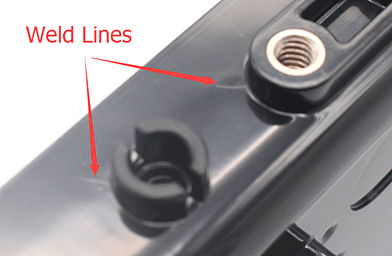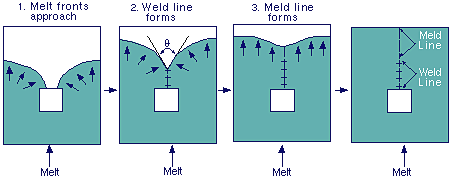
Weld lines is an important factor affecting the quality of plastic parts.Under the same process conditions, the strength of the weld line area is only 10-92% of the original material, which seriously affects the normal use of the injection molded product.
What is the weld line of injection molded parts
The “welding lines” of plastic products means that the morphological structure and mechanical properties formed when two molten materials are in contact are completely different from the three-dimensional regions of other parts.

There are two basic types of weld marks in injection molded parts: one is due to the structural characteristics of the plastic part or the size is large, in order to reduce the melt flow and filling time, when two or more gates are used, The weld marks formed by the melt fronts entering the cavity with different gates are called cold-melt joints. The other is that when the cores and inserts are installed in the cavity, the melt is divided into two when it passes through the obstacles. The strands, after the obstacles are bypassed, the two melts rejoin and form a weld line, called a hot-melt joint.
Influencing factors of weld lines:
a. The effect of temperature. Increasing the melt temperature helps to reduce the depth of the V-shaped port on the surface of the plastic part.
b.Injection pressure and holding pressure.
c. Effect of injection speed and injection time.
d.Design of the gating system. The gate should not be too much.
e.Design of exhaust system and Cold-slug.
f.Temperature control system design.The lower the mold temperature, the worse the melt is fully fused.
g.Design of surface roughness of cavity and core.
Improvement measures:
1.Vibration assisted injection molding.
2.Double push filling method.
3.Sequential valve gate technology.
4.The utility model relates to a mold structure capable of eliminating the appearance of weld lines of a hole-shaped injection molded product. The specific method is that when the product is just filled and filled in the cavity, the insert is used to cut the soft material melt in the cavity to obtain the product hole.
5.When the moving and fixed templates are not locked (with a gap of 2 mm), the injection molding is performed, and the second clamping is performed when the injection amount is 70%-80% of the required injection amount.
